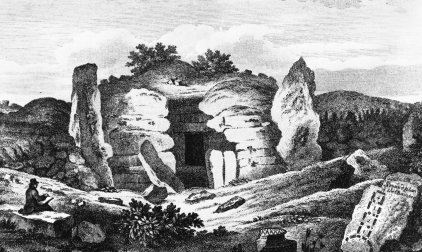


Annacloghmullin, County Armagh
'The gradual decay, and, in too many instances, the complete destruction of our ancient monuments, must be deplored by every Irishman who truly loves his country.. The plough, the spade and the chisel have been employed in removing many of our prehistoric remains, because in this utilitarian age they have been considered impediments to modern improvements'.- William Gray, 1883
 Though it no longer exists, this monument is included because, as depicted in a rare early engraving, it shows just how impressive some of the larger undisturbed court tombs must have appeared. It stood in Killeevy parish below the eastern slope of Slieve Gullion, and was opened and explored by Sir Walter Synnot in 1791.
Though it no longer exists, this monument is included because, as depicted in a rare early engraving, it shows just how impressive some of the larger undisturbed court tombs must have appeared. It stood in Killeevy parish below the eastern slope of Slieve Gullion, and was opened and explored by Sir Walter Synnot in 1791.Annacloghmullin did not survive long after discovery, most of its fine stones being carted away to build grand houses, but an account by John Bell published in The Newry Magazine in 1815 provides a valuable record of its structural features. His description of the gallery with its corbelled roof is particularly instructive. Thirty-seven feet in length, it contained four burial chambers (which he refers to as 'apartments') separated by sills:
'From the sides and ends of these apartments, springing from the top of the vertical wall-stones, large flags which form the roof, project one over the other, until they nearly meet at the top, the stones at the ends converging as well as those of the sides. An immensely large and ponderous slab is placed horizontally on the two uppermost of these, which respective stones form the highest part of the several apartments'. The interior floor to roof height is given as 7 1/2 feet.
The covering cairn, 44 yards long by 24 yards wide, was intact when dug into to expose the entrance to the tomb which, as the engraving shows, was flanked by a pair of massive orthostats. Similar flanking stones are still to be seen at Clontygora court tomb in the same county, the skeletal remains of which are perhaps the closest parallel to long-lost Annacloghmullin.
Other Ancient Stones in County Armagh:
Aghmakane | Annaghmare | Ballykeel | Ballymacdermot | Clonlum | Clontygora | Kilnasaggart | Slieve Gullion
Click here to buy the Appletree Press book from Amazon.co.uk. For more information click on: Ireland's Ancient Stones - A Megalithic Heritage by Kenneth McNally, published by Appletree Press.
All Material © 1999-2008 irelandseye.com and contributors Privacy statement
